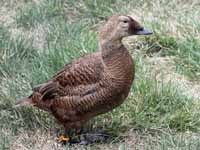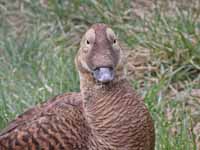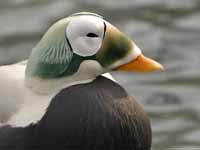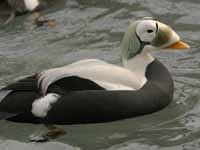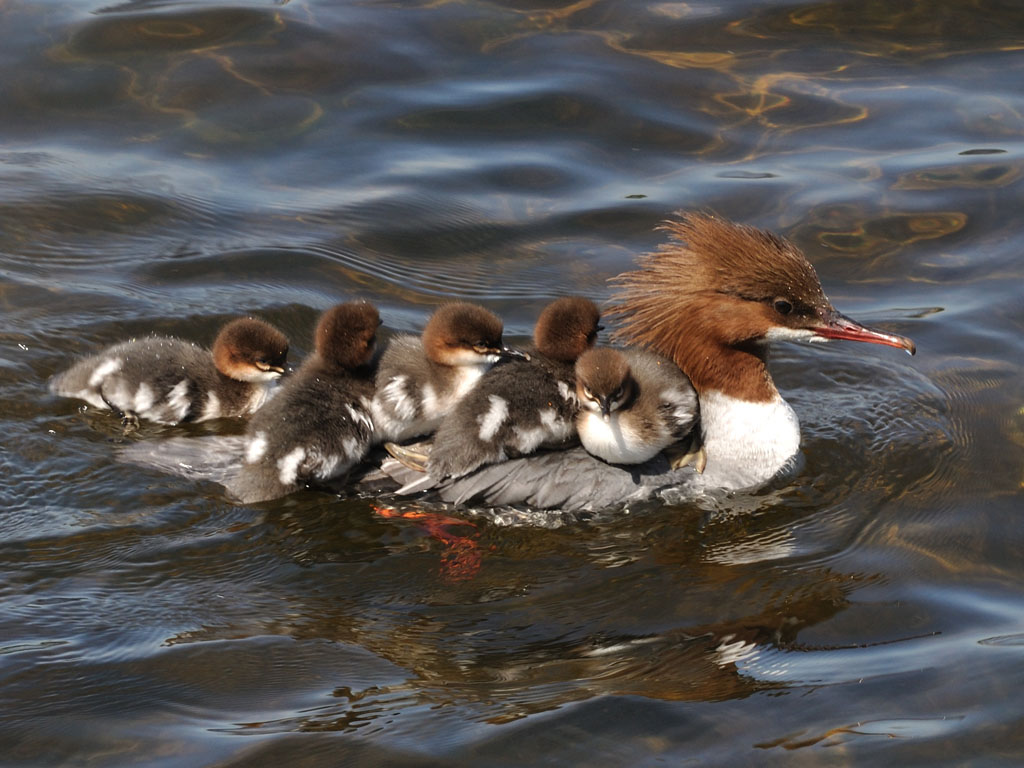The term waterfowl is used to describe any member of the order Anseriformes. A series of articles describes all the waterfowl. This specific article describes the "sea ducks " which belong to family Anatidae, subfamily Merginae.
Anseriformes
Most species of the order Anseriformes spend a considerable amount of time in water. In fact, they are called waterfowls. Their webbed feet make for efficient swimming. A few species spend little time in water and thus their feet are only partially webbed. Most waterfowl are also good flyers, many migrating long distances to escape the cold and others migrating shorter distances for optimizing their food supply. All species, except the screamers, have a wide and relatively flat bill. The shape of a species bill and also their tongue is a function of their diet. Considering the entire order, they eat aquatic plants, grasses, sedges, algae, plankton, insects, insect larvae, mollusks, crustaceans, fish, fruits, grains, rice. Most species are monogamous and if they lose a partner seem to mourn. Males are larger and heavier than females. The chicks are well developed when they hatch and can walk almost immediately.
The order Anseriformes has 3 familes: Anatidae, Anhimidae, Anseranatidae. Family Anatidae is comprised of the ducks, swans, and geese which amounts to about 160 species. Family Anhimidae is made up of 3 screamer species while family Anseranatidae has only one species, the magpie goose. Since these latter two families contain so few species, it seems appropriate to consider the entire order in this series of articles.
Anatidae
The Anatidae family has the following subfamiles:
Anatinae: dabbling ducks and teals
Anserinae: geese, swans
Aythyinae: diving ducks
Dendrocygninae: whistling ducks
Merginae: sea ducks
Oxyurinae: stiff-tailed ducks
Plectropterinae: spur-winged goose
Stictonettinae: freckled duck
Tadorninae: shelducks, shelgeese
Sea Ducks
Most sea ducks are essentially marine outside the breeding season, hence their name. Many species have developed specialized salt glands to allow them to drink salt water. But often the young cannot process salt water which helps explain why sea duck breeding sites are near freshwater. These breeding sites are in northern latitudes near ponds and lakes.
There are 4 main groups of sea ducks: the goldeneyes and the bufflehead, the scoters, the mergansers, and the eiders. The 2 goldeneye species are similar in looks and quite small, about 500 gm. The bufflehead is twice as big, about 1000 grams. They all forage by diving.
There are 6 scoter species in genus Melanitta. They are fairly large sea ducks, the males reach about 1000 gm and the females a little smaller. Male scoters are mostly black with swollen bills; females mostly brown. They breed in northern latitudes, often in taiga or tundra habitats near freshwater. The winter more south to temperate climates usually along the coast. Scoter generally dive for their food, using feet and wings for propulsion. They eat crustaceans, mollusks, fish, aquatic insects and also some aquatic vegetation.
The mergansers are comprised of the "true" mergansers of genus Mergus, the smew (Mergellus albellus) and the hooded merganser (Lophodytes cucullatus). They vary greatly in size with the smew under 700 gms and the common merganser reaching 2000 gms. These "sea ducks" mainly eat fish. To help them grasp their prey, they have serrated edges on their long and thin bills. They capture fish by diving and chasing them under water. Even though they are in the sea duck subfamily Merginae, only the red-breasted merganser spends much time in the sea; the others almost exclusively find their fish in fresh waters.
Eiders breed in the cooler latitudes of the Northern hemisphere. They are famous for their "eiderdown" which is a great insulator and thus makes light and very warm feeling comforters. Except for Steller's eider which does not reach a kg, there are large birds with the male common eider averaging over 2000 gm and some reaching 3000 gm.
Genus Bucephala
The genus contains the bufflehead and the two goldeneye species. They all forage by diving and spend the breeding season at northern latitudes near freshwaters. The goldeneyes migrate slightly south, but the bufflehead goes considerable south, some to Mexico. They eat crustaceans, mollusks, insects, aquatic vegetation.
Bufflehead Bucephala albeola
Description: The male bufflehead has a black back and neck. The front of head is black and the back is white. It has white underparts and there is a white wing-patch. The female has dark brown upperparts including most of the head. She has pale grey underparts. There is a white oval behind the eye. She also has a white wing-patch, but it is smaller than the male's. During the non-breeding season, the male resembles a female, but with a larger white-wing-patch. Because of its unique head coloring, the male bufflehead should not be confused with any other species. The female bufflehead is similar to a female harlequin duck but that has two white patches on the side of its head while a female bufflehead only has one.
Range: North America.
Habitat: During breeding season, wooded lakes and ponds in Alaska and Canada, nesting in tree cavities often one previously used by a flicker. Winters at protected coastal areas or open inland waters.
Diet: Insects, crustaceans, mollusks. Also aquatic plants and fish eggs. Forages by diving.
Conservation status: Least Concern.
Image by: 1) Alan_D_Wilson - California 2, 3) Dick Daniels - Sylvan
4) Roy McBride - Vancouver, BC Range: North America.
Habitat: During breeding season, wooded lakes and ponds in Alaska and Canada, nesting in tree cavities often one previously used by a flicker. Winters at protected coastal areas or open inland waters.
Diet: Insects, crustaceans, mollusks. Also aquatic plants and fish eggs. Forages by diving.
Conservation status: Least Concern.
1, 2) Female 3, 4) Male
 Alan_D_Wilson_0495.jpg)

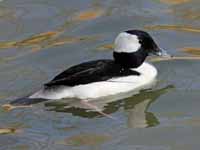
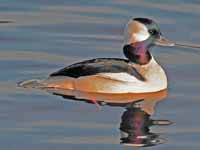
Goldeneye, Barrow's Bucephala islandica
Description: The male Barrow's goldeneye has golden colored eyes. Its black back has many white patches; the head and rump are also black. There is a white crescent on the cheek that is distinctive. The underparts are white and the bill is black. The female has a brown head and yellowish eyes, She has a grey back and tail; lighter grey breast and flanks. The female Barrow's goldeneye has a mostly yellow bill which differentiates it from the female common goldeneye with its black bill.
Range: Northern latitudes of North America, Iceland, Europe (rare).
Habitat: Breeds near alkaline lakes with few fish but many crustaceans. Winters in coastal areas with plentiful mollusks.
Diet: Crustaceans, mollusks, insects, aquatic vegetation. Forages by diving.
Conservation status: Least Concern.
Image by: 1) Donna Dewhurst, USFWS 2, 3, 4) Dick Daniels - Sylvan Heights Range: Northern latitudes of North America, Iceland, Europe (rare).
Habitat: Breeds near alkaline lakes with few fish but many crustaceans. Winters in coastal areas with plentiful mollusks.
Diet: Crustaceans, mollusks, insects, aquatic vegetation. Forages by diving.
Conservation status: Least Concern.
1, 2) Female 3, 4) Male



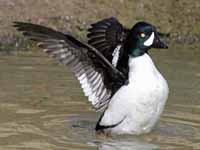
Goldeneye, Common Bucephala clangula
Description: The male common goldeneye has golden colored eyes. It has black upperparts and there is a distinctive oval patch on the check. The underparts are white and the bill is black. The female has a brown head and yellowish eyes, She has a grey back and tail; lighter grey breast and flanks. The female Barrow's goldeneye has a mostly yellow bill which differentiates it from the female common goldeneye with its black bill.
Range: Northern latitudes of North America and Europe.
Habitat: Nest in tree hollows in lakes and rivers of boreal forests. Winters in coastal areas with plentiful mollusks and crustaceans.
Diet: Crustaceans, mollusks, insects, aquatic vegetation. Forages by diving.
Conservation status: Least Concern.
Image by: 1) Peggy 2, 3, 4) Dick Daniels - Sylvan Heights Range: Northern latitudes of North America and Europe.
Habitat: Nest in tree hollows in lakes and rivers of boreal forests. Winters in coastal areas with plentiful mollusks and crustaceans.
Diet: Crustaceans, mollusks, insects, aquatic vegetation. Forages by diving.
Conservation status: Least Concern.
1, 2) Female 3, 4) Male
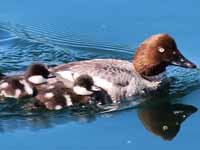
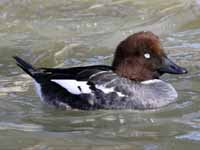
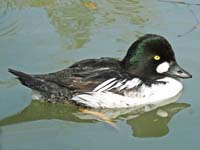

Genus Clangula - 1 species
Duck, Long-tailed Clangula hyemalis
Description: The long-tailed duck, also known as oldsquaw, has brown and white plumage with dark wings and the male has a long tail. The winter male has a mostly white head and neck with a dark cheek patch. The summer male has a dark neck, breast, and wings. mostly dark head with white face The bill is dark grey bill with some pink. The winter female has a white neck and head with a dark crown. The summer female has mostly brown upperparts and lighter flanks.
Range: North coast regions of: North America, Europe, Asia.
Habitat: During breeding season found near tundra wetlands, seacoasts, and large mountain lakes. During the winter found mainly along sea coasts and also the Great Lakes.
Diet: Mollusks, crustaceans, fish. Forages by diving using their wings to aid swimming which can get them down to 50 m. (200 ft.).
Conservation status: The long-tailed duck is Vulnerable. The biggest contributor to their declining population may be hunting, which kills about 20,000 long-tailed ducks per year. Lead poisoning from lead shots and also lead fishing sinkers may also be a contributor to their decline, even though lead bans have been in place for 20 years.
Image by: 1) Alan_D_Wilson 2) Dick Daniels - Alaska Sea Life Center, Seward Alaska 3) Wolfgang_Wander 4) Nasser_HalawehRange: North coast regions of: North America, Europe, Asia.
Habitat: During breeding season found near tundra wetlands, seacoasts, and large mountain lakes. During the winter found mainly along sea coasts and also the Great Lakes.
Diet: Mollusks, crustaceans, fish. Forages by diving using their wings to aid swimming which can get them down to 50 m. (200 ft.).
Conservation status: The long-tailed duck is Vulnerable. The biggest contributor to their declining population may be hunting, which kills about 20,000 long-tailed ducks per year. Lead poisoning from lead shots and also lead fishing sinkers may also be a contributor to their decline, even though lead bans have been in place for 20 years.
1) winter female 2) summer female 3) winter male 4) summer male
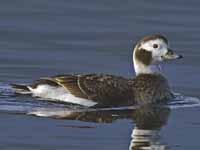

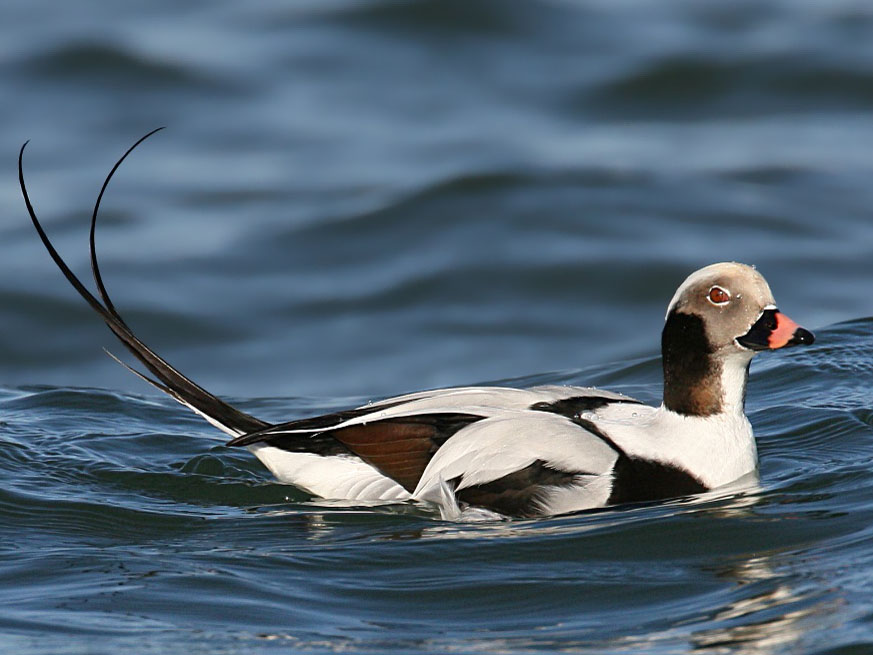
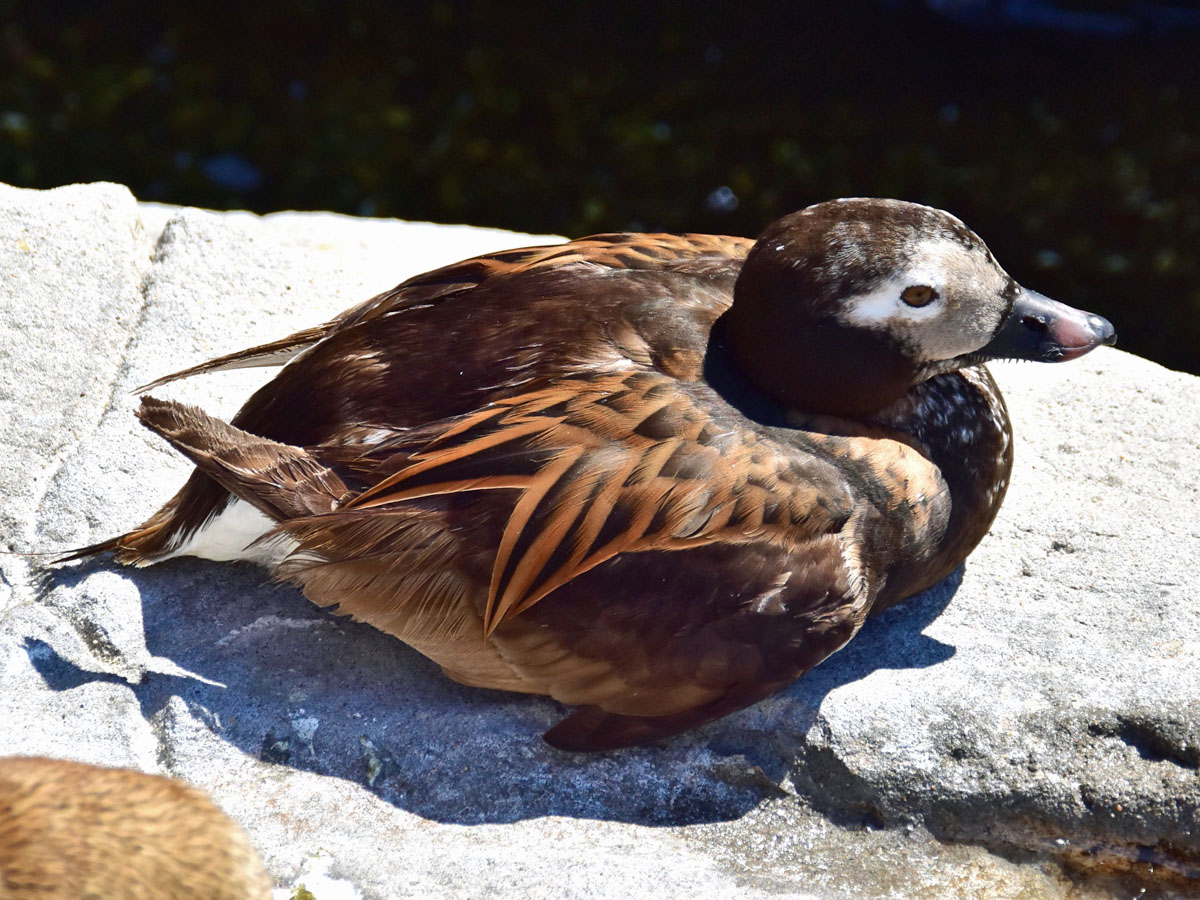
Genus Histrionicus - 1 species
Duck, Harlequin Histrionicus histrionicus
Description: The male harlequin duck is boldly marked like a clown. He has a blue-black head, breast, and back. There are white marks on the head, breast, and back. His sides are chestnut. The female has brownish-grey upperparts, mottled grey underparts, and a few white spots on the head. The female harlequin duck may be told from female buffleheads or long-tailed ducks by her 2 white spots on the side of her head. The similar female surf scoter has a much larger bill than the female harlequin.
Range: North America, Greenland, eastern Asia.
Habitat: Breeding harlequin forages in fast moving rivers and streams. Nonbreeding forages in coastal areas often in strong surf.
Diet: Mollusks, crustaceans, insects. Forages by diving, but also dabbles.
Conservation status: Least Concern.
Image by: 1, 2) Alan D Wilson - British Columbia 3, 4) Dick Daniels- Sylvan Heights Range: North America, Greenland, eastern Asia.
Habitat: Breeding harlequin forages in fast moving rivers and streams. Nonbreeding forages in coastal areas often in strong surf.
Diet: Mollusks, crustaceans, insects. Forages by diving, but also dabbles.
Conservation status: Least Concern.
1, 2) Female 3. 4) Male


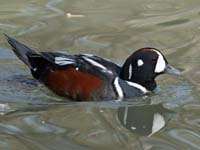
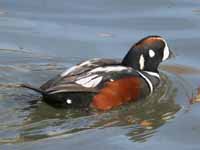
Genus Melanitta
The male scoters are mostly black with swollen bills; females mostly brown. They breed in northern latitudes, often in taiga or tundra habitats near freshwater. They winter more south to temperate climates usually along the coast. Scoters generally dive for their food, using feet and wings for propulsion. They eat crustaceans, mollusks, fish, aquatic insects and also some aquatic vegetation.
Scoter,_Black Melanitta americana
Description: The male black scoter is entirely black except for its bright yellow portion of its black bill. The female has brown plumage with pale cheeks. The common scoter is similar to the black scoter. The male common scoter has ablack knob at its bill base while the black scoter does not and has more yellow on the bill. The females are very similar, but that should not be a problem as their ranges do not overlap.
Range: North America, Asia (eastern Siberia) .
Habitat: Breeding habitat in boreal forest (taiga) with rivers and lakes. Winters along more southern coasts.
Diet: Mollusks, crustaceans, aquatic insects. Also aquatic vegetation.
Conservation status: The black scoter is Near Threatened. The biggest contributor to their declining population may be hunting, which kills about 10,000 long-tailed ducks per year. Commercial harvesting of mussels reduces their food supply and that may also be a factor.
Image by: 1) Jonathan_Coffin 2) Tom_Benson 3) Peter Massas 4) Andrew Reding - Washington Range: North America, Asia (eastern Siberia) .
Habitat: Breeding habitat in boreal forest (taiga) with rivers and lakes. Winters along more southern coasts.
Diet: Mollusks, crustaceans, aquatic insects. Also aquatic vegetation.
Conservation status: The black scoter is Near Threatened. The biggest contributor to their declining population may be hunting, which kills about 10,000 long-tailed ducks per year. Commercial harvesting of mussels reduces their food supply and that may also be a factor.
1, 2) Female 3) Juvenile male 4) Male
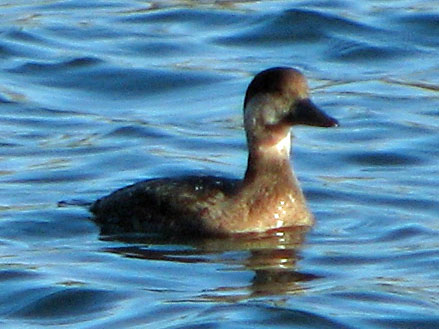



Scoter,_Common Melanitta nigra
Description: The male common scoter has black plumage. It has a bulbous black bill with yellow around nostrils. The female has mainly mottled brown plumage with pale cheeks. Her crown, which extends below the eyes, is grey-brown, darker at the front. Her bill is dark, sometimes with some yellow. The common scoter is similar to the black scoter. The male common scoter has black knob at its bill base while the black scoter does not and it has more yellow on the bill. The females are very similar. Their ranges do not overlap.
Range: Europe, Asia (north-east and north-central).
Habitat: Breeding habitat in boreal forest (taiga) and tundra with rivers and lakes. Winters along more southern coasts.
Diet: Mollusks, crustaceans, aquatic insects. Also freshwater fish.
Conservation status: Least Concern.
Image by: 1) JV Verde - Portugal 2) Stefan Bemdtsson 3) Mike_Prince 4) Jason Thompson - West Sussex Range: Europe, Asia (north-east and north-central).
Habitat: Breeding habitat in boreal forest (taiga) and tundra with rivers and lakes. Winters along more southern coasts.
Diet: Mollusks, crustaceans, aquatic insects. Also freshwater fish.
Conservation status: Least Concern.
1, 2) Female 3, 4, 5) Male
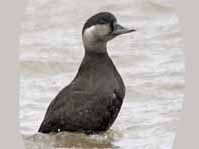

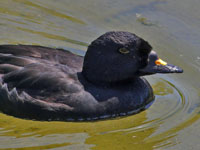
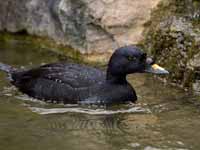 z
zScoter,_Stejneger's Melanitta deglandi
Description: The Stejnegers-scoter used to be conspecific with the white-winged scoter. Their ranges do not overlap. Males of the white-winged scoter have browner flanks, dark yellow coloration of most of the bill and a less tall bill knob. Females are identical in the field.
Range: Asia.
Habitat: Breeds near freshwater or brackish wetlands in the boreal forest and tundra. Winters along coast of Asia and also inland.
Diet: Mollusks, crustaceans, aquatic insects, fish. Dives to the bottom to forage.
Conservation status: Least Concern.
Range: Asia.
Habitat: Breeds near freshwater or brackish wetlands in the boreal forest and tundra. Winters along coast of Asia and also inland.
Diet: Mollusks, crustaceans, aquatic insects, fish. Dives to the bottom to forage.
Conservation status: Least Concern.
Scoter,_Surf Melanitta perspicillata
Description: The male surf scoter has a black body and a black head with white forehead and white nape. It has a unique large orange, white, and black bill. The female has mainly brown plumage and sometimes has a whitish nape patch. There are white patches on the cheeks and lores. Her bill is black with some blue and green. The female black scoter is similar, but does not have a white nape patch. The female harlequin duck has a much smaller bill.
Range: North America.
Habitat: Breeds in the boreal forests near northern freshwater lakes. Winters in marine habitats near the shore.
Diet: Freshwater invertegrates during breeding season. Otherwise mainly marine animals such as crustaceans, mussels, fish eggs.
Conservation status: Least Concern.
Image by: 1, 2) Alan D Wilson Huntington Beach, California 3) Mike Baird - CA, 4) Dick Daniels - Cape May, New Jersey ferryRange: North America.
Habitat: Breeds in the boreal forests near northern freshwater lakes. Winters in marine habitats near the shore.
Diet: Freshwater invertegrates during breeding season. Otherwise mainly marine animals such as crustaceans, mussels, fish eggs.
Conservation status: Least Concern.
1) Female 2 - 4) Male
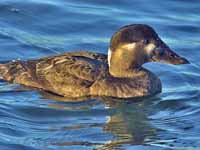
 Alan_D_Wilson_0105.jpg)
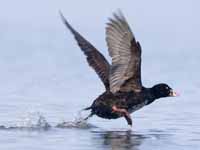
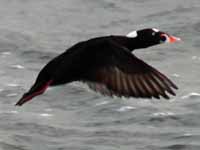
Scoter,_Velvet Melanitta fusca
Description: The male velvet scoter has black plumage except for a white crescent under the eye, a white speculum, and white under the wings. The bill is mainly yellow. The female is brown with pale head patches. The velvet scoter and white-winged scoter are sometimes considered conspecific. The male velvet scoter has considerably more yellow on its bill than does the white-winged scoter. The ranges do not overlap except for strays.
Range: Europe, western Asia.
Habitat: Breeds in the boreal forests and arctic tunda near freshwater. Winters in marine habitats near the shore
Diet: Mollusks, crustaceans, aquatic insects, fish. Dives to forage.
Conservation status: The velvet scoter is considered Vulnerable, even though the popultion may be close to 100,000, because the population has been declining steadily for decades.
Image by: 1) D_Gordon_Robertson - Scotland 2) Frank_Vassen - BelgiumRange: Europe, western Asia.
Habitat: Breeds in the boreal forests and arctic tunda near freshwater. Winters in marine habitats near the shore
Diet: Mollusks, crustaceans, aquatic insects, fish. Dives to forage.
Conservation status: The velvet scoter is considered Vulnerable, even though the popultion may be close to 100,000, because the population has been declining steadily for decades.
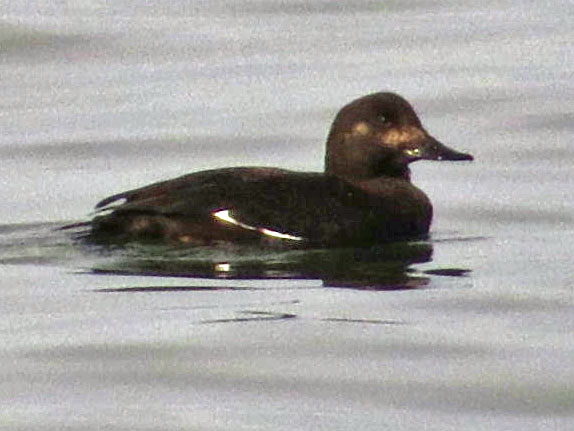
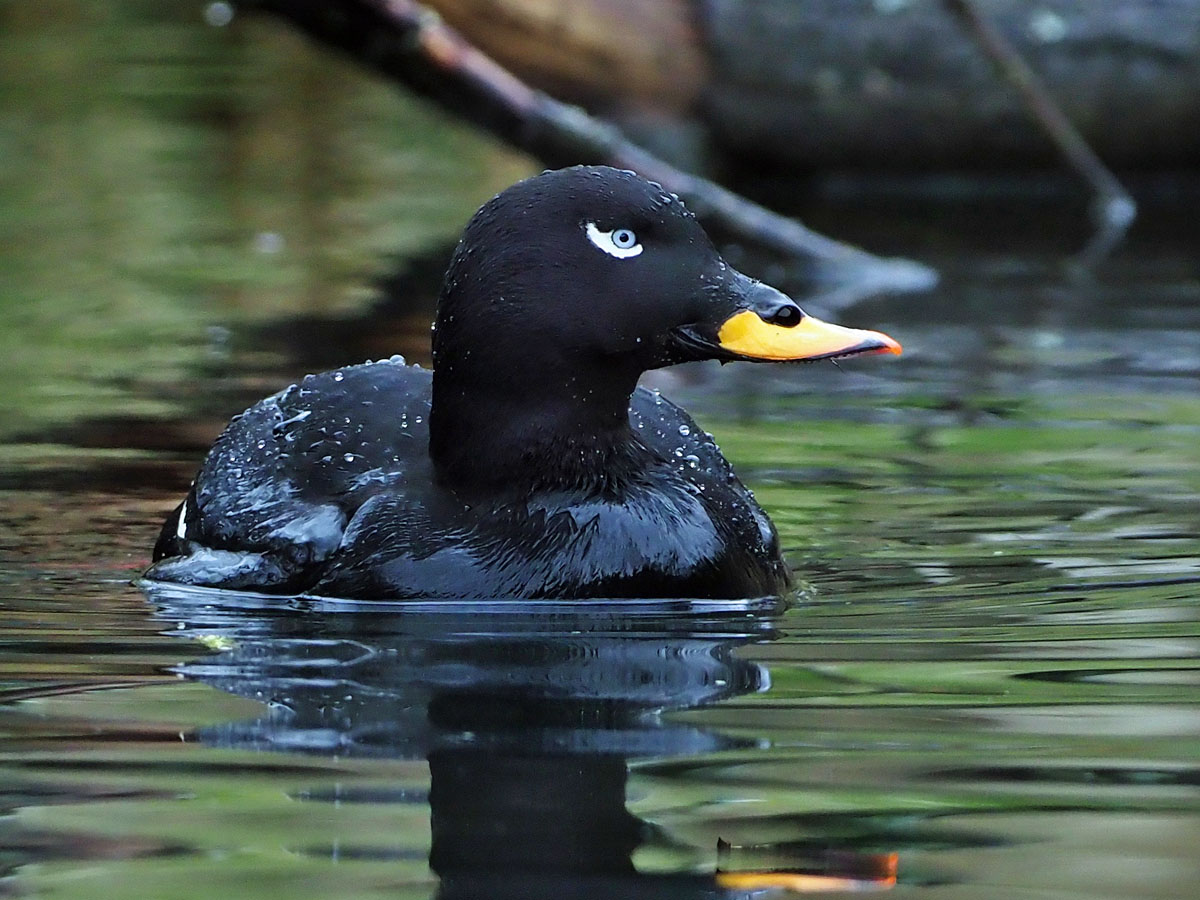
Scoter,_White-winged Melanitta deglandi
Description: The white-winged scoter is the largest of the scoters and tends to be further inland than surf or black scoters. Little can be seen of its white wings when it is not flying. The male has black plumage except for a white crescent under the eye, a white speculum, and white under the wings. The bill is grey and black with a knobby base and a patch of yellow. The female is brown and some have pale head patches. The black scoter and white-winged scoter are similar. The white crescent identifies the male white-winged scoter as may the white patches on the female's head.
Range: North America.
Habitat: Breeds near fresh or brackish wetlands in the far north of North America. Winters along east and west coastlines of more temperate North America.
Diet: Mollusks, crustaceans, aquatic insects. Also freshwater fish. Dives to the bottom to forage.
Conservation status: Least Concern.
Image by: 1) USFWS 2) Elaine
R Wilson - British Columbia 3) Alan D. Wilson - British Columbia 4) Andrew_RedingRange: North America.
Habitat: Breeds near fresh or brackish wetlands in the far north of North America. Winters along east and west coastlines of more temperate North America.
Diet: Mollusks, crustaceans, aquatic insects. Also freshwater fish. Dives to the bottom to forage.
Conservation status: Least Concern.
1) Female 2, 3, 4) Male
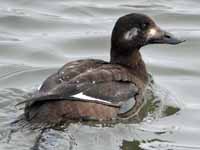


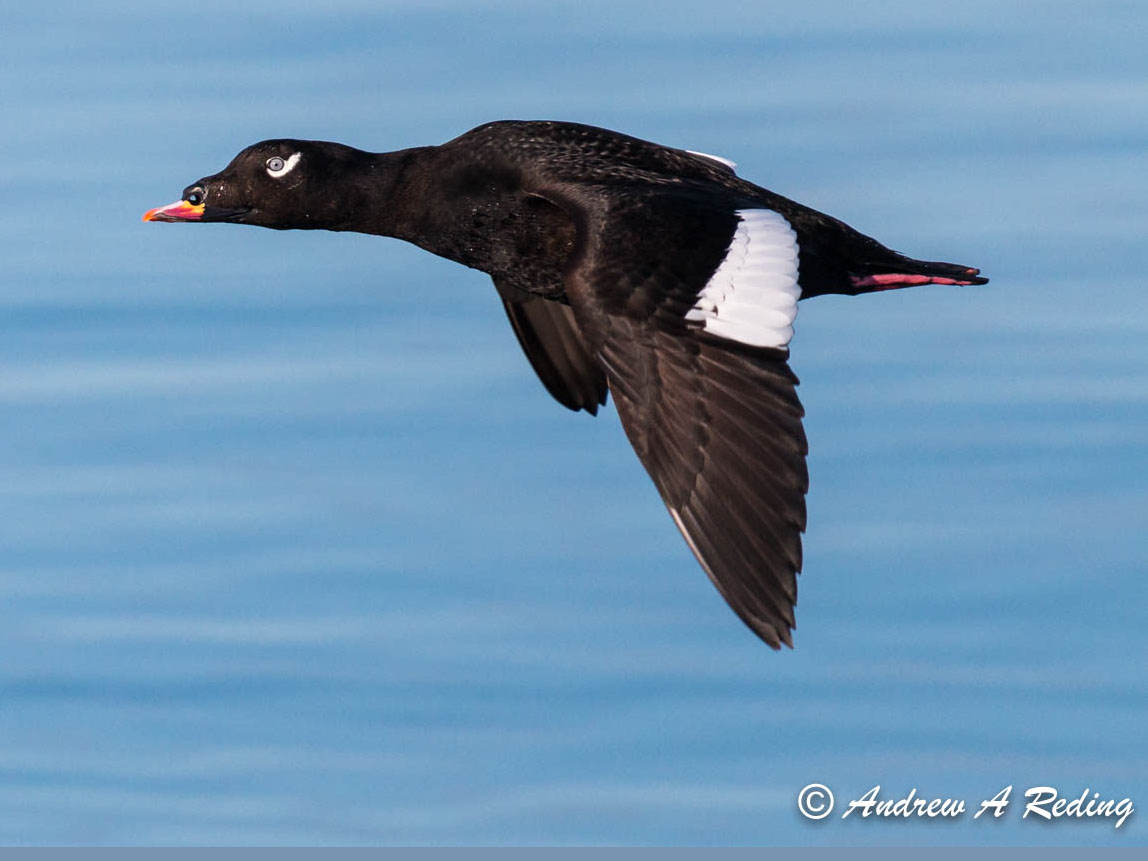
Mergansers
The mergansers are comprised of the "true" mergansers of genus Mergus, the smew (Mergellus albellus) and the hooded merganser (Lophodytes cucullatus). These "sea ducks" mainly eat fish. To help them grasp their prey, they have serrated edges on their long and thin bills. They capture fish by diving and chasing them under water. Even though they are in the sea duck subfamily Merginae, only the red-breasted merganser spends much time in the sea; the others almost exclusively find their fish in fresh waters.
All except the Brazilian merganser are restricted to the Northern Hemisphere. Of these northern species, all spend the breeding season way north - many in tundra and taiga regions. Even in the winter, they do not travel to real warm climates; their main concern is that ice does not prevent them from finding fish. Except for one exception, which is again the Brazilian merganser, all females have similar looking heads - reddish-brown with a long and thin bill. The female Brazilian has a black head. And except for the smew, all male mergansers have a black head, again with a long thin bill.
Genus Lophodytes - 1 species
Merganser,_Hooded Lophodytes cucullatus
Description: The male hooded merganser often raises the head feathers which produces a hooded effect. He has a black head with a white patch on the side; the size of the patch varies depending on whether or not the hood is raised. It has a mainly black back, white breast with a black stripe, reddish-brown sides, and yellow eyes. The female has a reddish head with crest, greyish-brown body which is darker on the mantle, and brown eyes. The nonbreeding male resembles the female, but has yellow eyes instead of brown. The female hooded merganser is similar to the common merganser and also the red-breasted merganser. The hooded merganser is considerably smaller than either of these plus its chin and throat is paler.
Range: North America.
Habitat: Breeding habitat includes a wide variety of freshwater wetlands. During winter uses shallow lakes and brackish coastal waterbodies.
Diet: Mainly fish. Also insects, crabs, crayfish.
Conservation status: Least Concern.
Image by: 1) BS_Thurner_Hof 2, 3, 4) Dick DanielsRange: North America.
Habitat: Breeding habitat includes a wide variety of freshwater wetlands. During winter uses shallow lakes and brackish coastal waterbodies.
Diet: Mainly fish. Also insects, crabs, crayfish.
Conservation status: Least Concern.
1, 2) Female 3, 4) Breeding male
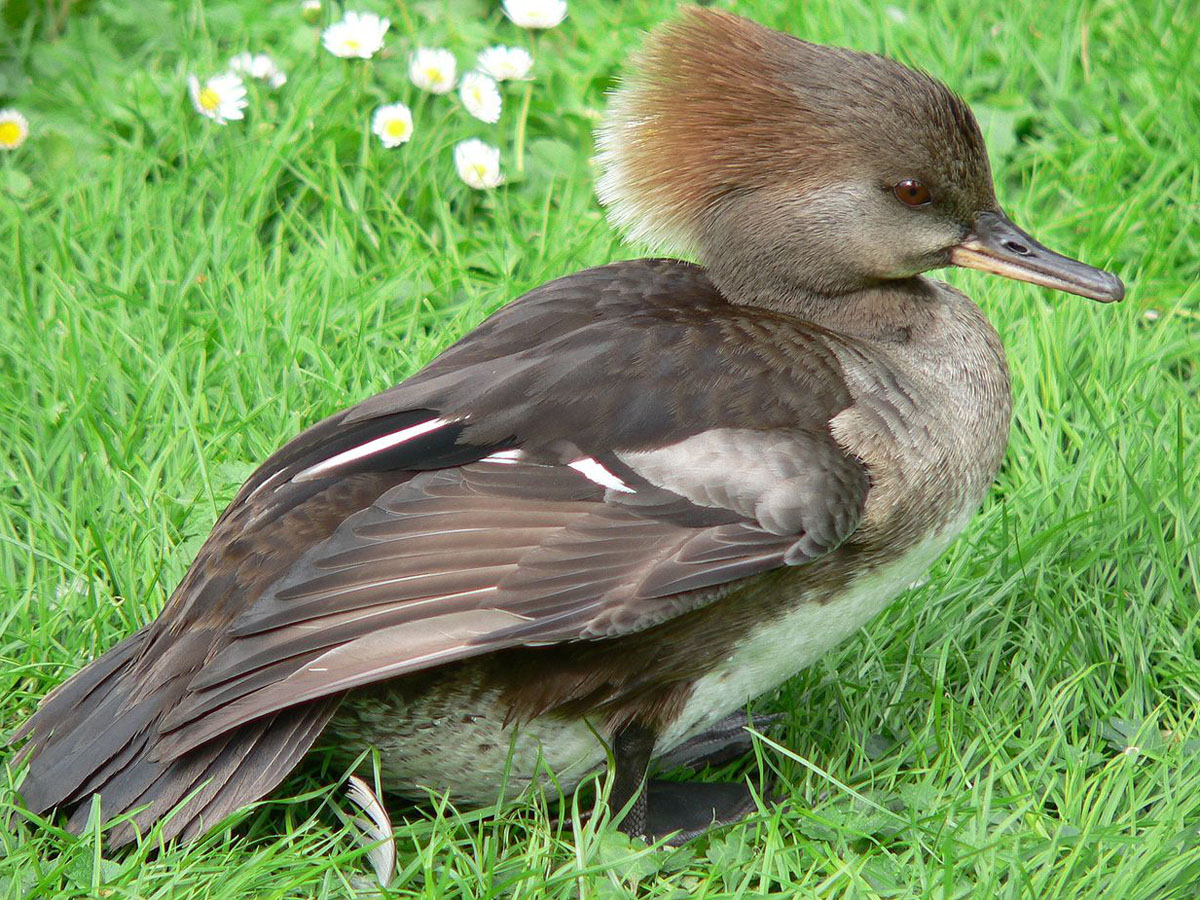
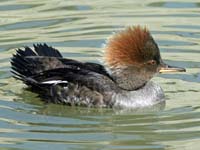


Genus Mergellus - 1 species
Smew Mergellus albellus
Description: The male smew should not be confused with any other species. It has a black mantle and grey flanks. There is a black eye patch.The rest of the body is white with distinguishing black lines. The female Smew has a grey body, red nape, white throat, brownish red head and nape. She is similar to other female mergansers, but unique with the white face and throat.
Range: Europe, Asia.
Habitat: Breeds in northern taiga of Europe and Asia. Needs an environment with trees and waterbodies that have plentiful fish. Winters on ice-free waterbodies which are freshwater or brackish but not saline.
Diet: Mainly fish. Also mollusks, insects, aquatic vegetation. Forage many by pursuit diving, sometimes cooperatively in large groups.
Conservation status: Least Concern.
Image by: 1, 2, 3, 4)
- Dick Daniels -Sylvan Heights Range: Europe, Asia.
Habitat: Breeds in northern taiga of Europe and Asia. Needs an environment with trees and waterbodies that have plentiful fish. Winters on ice-free waterbodies which are freshwater or brackish but not saline.
Diet: Mainly fish. Also mollusks, insects, aquatic vegetation. Forage many by pursuit diving, sometimes cooperatively in large groups.
Conservation status: Least Concern.
1, 2) Female 3, 4) Male

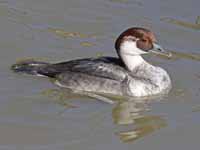


Genus Mergus
Most of these "sea ducks" actually prefer rivers, streams, and also lakes. The red-breasted merganser is an exception and in the winter season it prefers coastal waters. These Mergus mergansers have long thin bills with serrated edges which helps to firmly hold fish which is their primary food. They may first put their head under water to spot a fish and then dive to pursue it. They often go upstream as they are hunting so that the water where they are hunting remains clear and undisturbed.
Merganser,_Brazilian Mergus octosetaceus
Description: The Brazilian merganser has dark grey upperparts, shiny dark green hood with crest, light grey breast, whitish belly, and a white wing patch. It has a thin jagged black bill, red legs, and red feet. The female has same the same color plumage but with a smaller bill and crest. This sea duck is an exception to the rule that they occur just in northern latitudes.
Range: Brazil, Argentina.
Habitat: Mountainous regions where it inhabits clean rivers and streams with rapid flows. They avoid areas with much human population.
Diet: Mainly fish; also insects.
Conservation status: The Brazilian merganser is Critically Endangered because of habitat degradation. Rivers are becoming silted because of poor farming techniques or logging. Hydroelectric dams are reducing the number of fish.
Image by: 1) Nick Athanas - Brazil 2) Claudio Timm 3) Savio Bruno - Brazil Range: Brazil, Argentina.
Habitat: Mountainous regions where it inhabits clean rivers and streams with rapid flows. They avoid areas with much human population.
Diet: Mainly fish; also insects.
Conservation status: The Brazilian merganser is Critically Endangered because of habitat degradation. Rivers are becoming silted because of poor farming techniques or logging. Hydroelectric dams are reducing the number of fish.
1) Pair, male on left 2) Female 3) Male

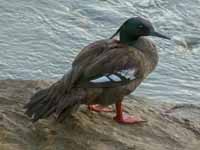
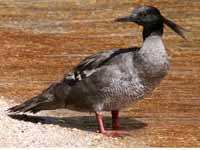
Merganser,_Common Mergus merganser
Description: The breeding male common merganser, also known as a gossander, has a black head and back. The underparts and neck are white. The female and eclipse male have a reddish-brown head, white neck, grey back and underparts. The female has white under her chin. She is similar to the female hooded merganser and the female red-breasted merganser, but neither of these have white chins.
Range: North America, Europe, Asia.
Habitat: In breeding season, northern lakes and rivers with tree hollows close by for nest. Winters further south on mainly fresh water bodies; nearby trees not then a necessity.
Diet: Almost exclusively fish, except chicks eat insects and some flies.
Conservation status: Least Concern.
Image by: 1, 3) Dick - Sylvan Heights 2) Ted
Grussing -
Arizona 4) Tony_Hisgett - EnglandRange: North America, Europe, Asia.
Habitat: In breeding season, northern lakes and rivers with tree hollows close by for nest. Winters further south on mainly fresh water bodies; nearby trees not then a necessity.
Diet: Almost exclusively fish, except chicks eat insects and some flies.
Conservation status: Least Concern.
1, 2) Female 3, 4) Male
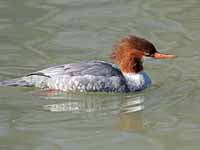
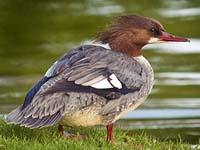

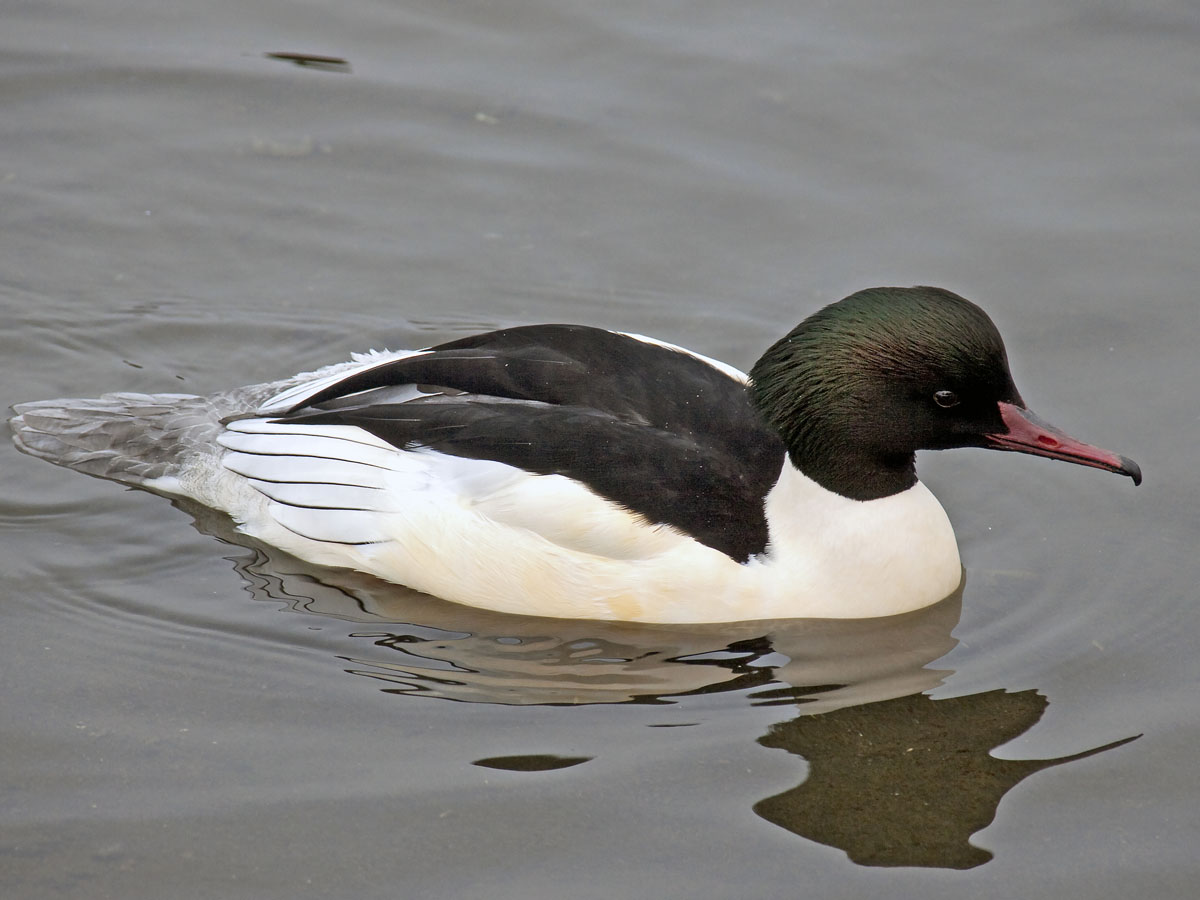
Merganser,_Red-breasted Mergus serrator
Description: The red-breasted merganser has a long, thin red bill, fuzzy to spiky head feathers, and a white speculum. The male has a black head and back, white neck and underparts, and a rusty to dark breast. The female has a rusty head, grey upperparts, and light underparts. The female red-breasted merganser has a darker face than the considerable smaller female hooded merganser. The female common merganser has white under its chin while the red-breasted doesn't.
Range: North America, Europe, Asia.
Habitat: Breeds near freshwater lakes and rivers across northern North America, Greenland, Europe, and the Palearctic. It nests in sheltered locations on the ground near water. Winters along the coasts.
Diet: Mainly fish which it captures by pursuit swimming. Also, insects, crustaceans, frogs.
Conservation status: Least Concern.
Image by: 1) Phil_Graham 2) Alan D Wilson - California 3) peggycadigan 4) Ingrid Taylor - Range: North America, Europe, Asia.
Habitat: Breeds near freshwater lakes and rivers across northern North America, Greenland, Europe, and the Palearctic. It nests in sheltered locations on the ground near water. Winters along the coasts.
Diet: Mainly fish which it captures by pursuit swimming. Also, insects, crustaceans, frogs.
Conservation status: Least Concern.
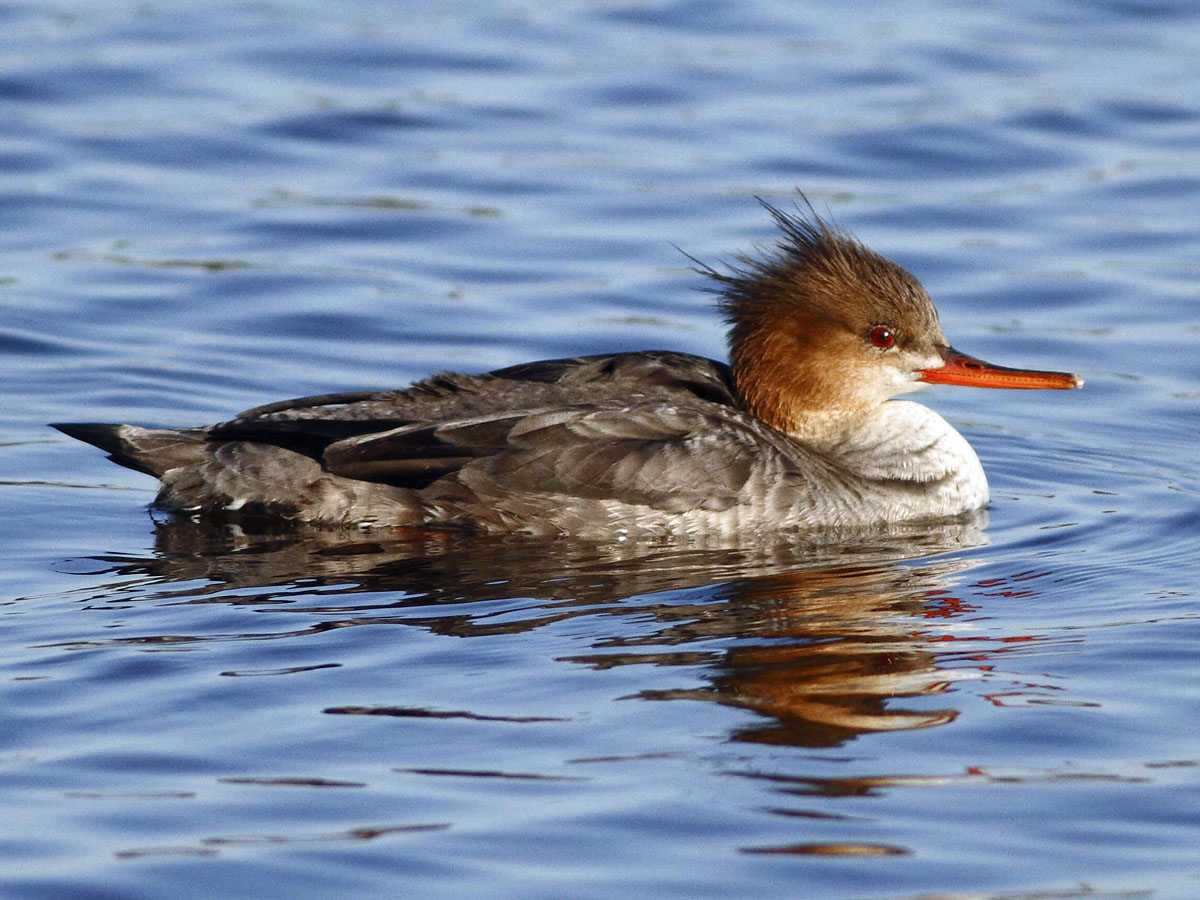
 Alan_D_Wilson_2686.jpg)
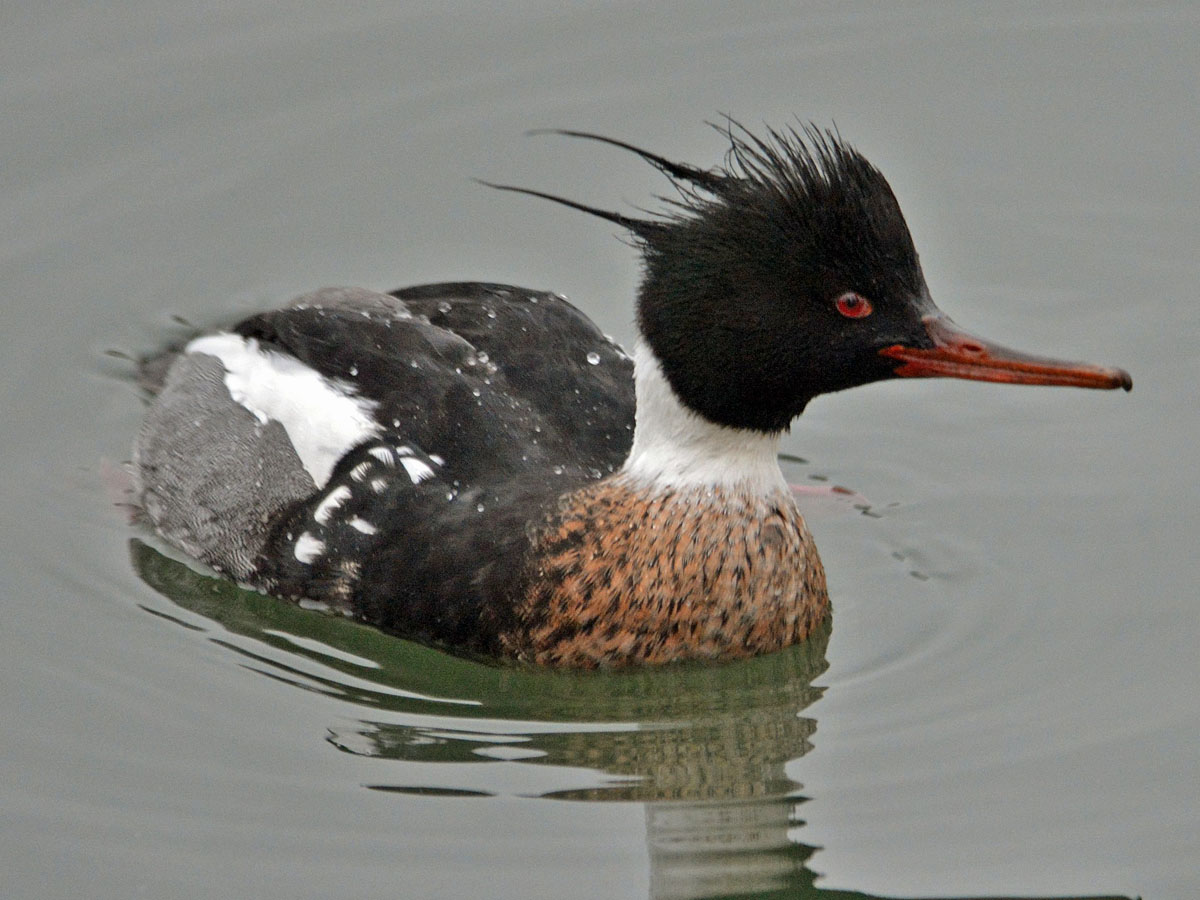

Marganser,_Scaly-sided Mergus squamatus
Description: The scaly-side merganser, also known as the Chinese merganser, has patterns on the flanks that resemble scales. It has a long thin red bill, reddish-orange eyes and legs. The male has black upperparts including the head and white underparts. The female has a reddish-brown head and a grey back.
Range: Asia.
Habitat: During breeding season mountain streams and rivers in the northern taiga region far from civiliization. Also streams and rivers in the winter, but further south. In the winter it also frequents lakes.
Diet: Mainly fish.
Conservation status: They are Endangered because of silting of rivers from mining and logging. Their population seems to have stabilized at about 5000.
Image by: 1) Dick Daniels -Sylvan Heights 2, 3) BS Thurner Hof 4) Massimiliano_SticcaRange: Asia.
Habitat: During breeding season mountain streams and rivers in the northern taiga region far from civiliization. Also streams and rivers in the winter, but further south. In the winter it also frequents lakes.
Diet: Mainly fish.
Conservation status: They are Endangered because of silting of rivers from mining and logging. Their population seems to have stabilized at about 5000.
1) Pair 2) Female 3, 4) Male

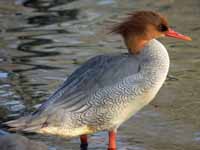


Eiders
Eiders are large sea ducks. They breed in the cooler latitudes of the Northern hemisphere. They are famous for their eiderdown which is a great insulator and thus makes light and very warm feeling comforters. The female common eider plucks the down from her breast to line the nest. The resulting nest is thus soft and warm. After the eiders vacate the nest, people harverst the eider so this is a very ecofriendly material - no birds need be killed when it is commercially obtained. Of course, not only does eiderdown help the young with their comfortable nest, it also provides the adults with great insulation. These warm eiders are able to stay in harsh winter climates as long as there is open water for swimming. In addition to eiderdown, some geese and ducks have been domesticated because they also have down with good insulating properties, but not as good as the eider's.
Genus Polysticta - 1 species
Eider, Steller's Polysticta stelleri
Description: The male Steller's eider is unmistakable with its black upperparts and neck collar, white head and yellowish underparts. The folded wings give a striped look to the back. The female is a dark brown bird, with a more typically duck-shaped head and body than other eider species.
Range: North America, Europe, Asia. They are mainly found in Alaska.
Habitat: Breeds in northern tundra regions at the coast and also well inland near ponds and lakes. Winters somewhat south, requiring unfrozen water for foraging. If a shallow bay freezes, it may move to deep water rather going even further south.
Diet: Mainly mussels. Also crustaceans, fish, worms, aquatic vegetation. It forages mainly by diving.
Conservation status: Steller's eider is listed as Vulnerable even though there may be a population of 200,000. They live in remote northern areas and cannot be easily monitored. They have suffered from oil spills and perhaps global warming is damaging their environment.
Image by: 1) Laura Whitehouse 2) Glen Smart, USFWS 3, 4) Ron_KnightRange: North America, Europe, Asia. They are mainly found in Alaska.
Habitat: Breeds in northern tundra regions at the coast and also well inland near ponds and lakes. Winters somewhat south, requiring unfrozen water for foraging. If a shallow bay freezes, it may move to deep water rather going even further south.
Diet: Mainly mussels. Also crustaceans, fish, worms, aquatic vegetation. It forages mainly by diving.
Conservation status: Steller's eider is listed as Vulnerable even though there may be a population of 200,000. They live in remote northern areas and cannot be easily monitored. They have suffered from oil spills and perhaps global warming is damaging their environment.
1, 2) Female 3, 4) Male
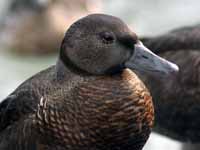
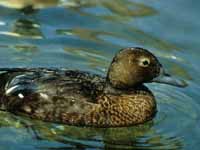


Genus Somateria
These eiders all breed in the cooler latitudes of the Northern Hemisphere.
Eider, Common Somateria mollissima
Description: The common eider, the largest eider, has a large wedge shaped bill. The breeding male is unmistakeable. It has a black crown, lower-breast, belly, and tail. The nape is green while the rest of the plumage is white. The female has brown plumage. Because of the shape of her head, she should only be confused with a female king eider. The female king eider has a white arc above the eye, the common eider does not. The common eider is the largest duck in the Northern Hemisphere.
Range: North America, Europe, eastern Siberia.
Habitat: Breeds in the Arctic at or near the coast. Adults can drink salt water, but chicks require fresh, During the winter they like rocky coastal areas which are ice free.
Diet: Mollusks, crustaceans, fish. Usually dives for food, but may dabble for mollusks. The common eider can dive to 20 meters (75 ft) to forage at the sea bottom.
Conservation status: The common eider is considered Near Threatened, even though the population is over 3 million, because of worries about overhunting and human disturbances at nesting sites.
Image: 1) Amanda Boyd, USFWS 2) Dick Daniels - Sylvan Heights 3 Dick - Scotland 4) Steve Garvie - Scotland Range: North America, Europe, eastern Siberia.
Habitat: Breeds in the Arctic at or near the coast. Adults can drink salt water, but chicks require fresh, During the winter they like rocky coastal areas which are ice free.
Diet: Mollusks, crustaceans, fish. Usually dives for food, but may dabble for mollusks. The common eider can dive to 20 meters (75 ft) to forage at the sea bottom.
Conservation status: The common eider is considered Near Threatened, even though the population is over 3 million, because of worries about overhunting and human disturbances at nesting sites.
1, 2) Female 3, 4) Male
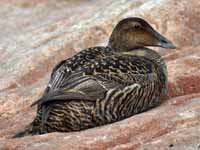

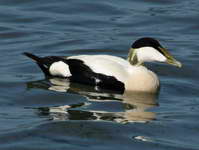
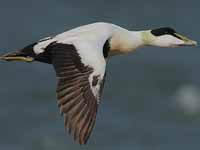
Eider, King Somateria spectabilis
Description: The breeding male King Eider has a black belly, lower back, and tail. The crown, forehead, and nape are light blue. The rest of the plumage is white. His bill is red and there is a striking pale yellow frontal lobe above the bill and that lobe is outlined in black. The female is mottled brown with a white arc above the eye. Both sexes of the king eider have stubbier bills than the common eider. That is one way to tell the species apart, although the difference is obvious for males even without comparing bills. The base of the female King Eider's bill gives the appearance of a smile.
Range: North America, northeast Europe, Asia.
Habitat: Nests in Arctic tundra near ponds and lakes. Winter far enough south so there is open water in the sea.
Diet: During breeding season, dabbles in freshwater for small invertebrates. During the winter dives at sea for mollusks, crabs, starfish, and more.
Conservation status: Least Concern.
Image by:
1) Ómar Runólfsson - Iceland 2, 3) Dick Daniels - Alaska Sea Life Center in Seward 4) Ron_KnightRange: North America, northeast Europe, Asia.
Habitat: Nests in Arctic tundra near ponds and lakes. Winter far enough south so there is open water in the sea.
Diet: During breeding season, dabbles in freshwater for small invertebrates. During the winter dives at sea for mollusks, crabs, starfish, and more.
Conservation status: Least Concern.
1) Breeding female 2) Nonbreeding female 3) Nonbreeding male 4) Breeding male
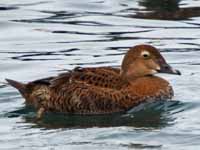
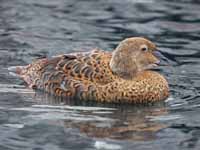
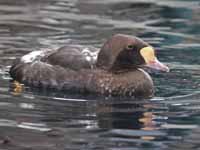
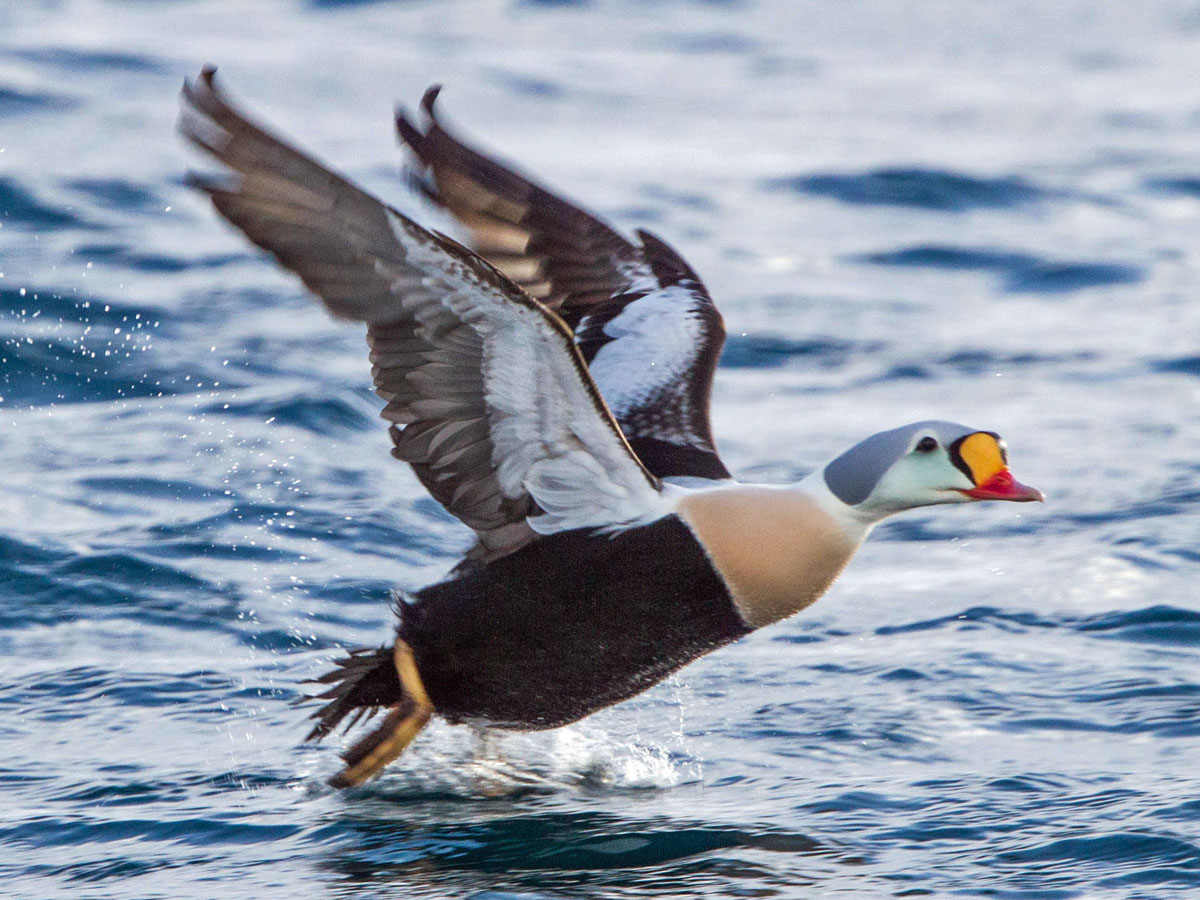
Eider, Spectacled Somateria fischeri
Description: The Spectacled Eider can be distinguished from other eiders by its spectacle-like eye patches. The spectacles are bright white for the male, not as vivid for the female, but still quite evident. The male has a white back and black underparts. The head is mainly yellow-green with large white spectacle-like patches and a white border above the yellow bill. The female has brown plumage with pale spectacle-like patches.
Range: North America, easternmost Russia.
Habitat: Nesting stes within 20 km of shore at freshwaters wetlands. Winters in the Bering Sea.
Diet: Mollusks while at sea and aquatic insects, crustaceans, and plant material while on the breeding grounds.
Conservation status:The spectacled eider is Near Threatened because their population is declining, possibly because of climate change.
Image by: 1, 2 Dick Daniels - Sylvan Heights 3, 4) Laura Whitehouse Range: North America, easternmost Russia.
Habitat: Nesting stes within 20 km of shore at freshwaters wetlands. Winters in the Bering Sea.
Diet: Mollusks while at sea and aquatic insects, crustaceans, and plant material while on the breeding grounds.
Conservation status:The spectacled eider is Near Threatened because their population is declining, possibly because of climate change.
1, 2) Female 3, 4) Breeding male
